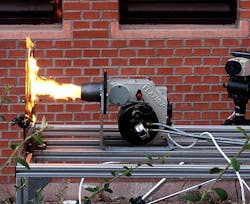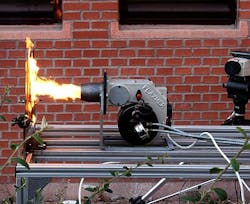Madrid, Spain--Researchers at Universidad Carlos III de Madrid (UC3M) are developing an infrared (IR) measuring method to analyze the thermal properties and resistance to fire of composite materials. This advance would have applications in aerospace engineering and other areas where fire safety requires that composite materials withstand high temperatures.
The main problem associated with measuring the effects of fire on materials lies in the temperature of the flames, which reaches over 1000ºC and can obscure the actual temperature of the material. In addition, there is the problem of the high concentration of gases (CO2, H2O, and others), which makes it difficult to obtain clear images of the sample being subjected to fire. In order to solve this problem, the UC3M researchers used a measurement that utilizes the IR spectrum. To accomplish this, the researchers used an IR camera with the proper spectral settings that allowed them to determine the measurement, discounting the flame's fanning effects, explains Fernando López, a tenured professor in the physics department at UC3M, and one of the study's authors.
The research, which was carried out at the Laboratorio del Infrarrojo at UC3M (LIR â Infrared Laboratory; LIR-UC3M) in collaboration with the Airbus Systems Laboratory, has applications in the aeronautical industry, where it is essential to know what effects fire will have on composite materials (fiberglass, carbon fiber, etc.) that are used in airplanes. Moreover, this method could be applied in other sectors where a material's resistance to fire is crucial, such as in rail and land transport or fire protection in housing.
The advantage of using this method of measurement is that it can be done without any direct contact with the material, almost instantly (in milliseconds) and under severe conditions (when flames are present), the researchers explain. The main objective is to quickly and precisely measure the real temperature of the sample over the entire surface, including the part that is hidden by the flames, and to do this from a distance, says López. "All of this, as a function of time, and taking into consideration the rise and fall of the temperature over time," he adds.
Another line of investigation currently being developed by the researchers is one that allows them to measure, from a distance, the thermodynamic parameters of materials (emissivity and diffusivity, coefficients of conductivity, and specific heat), by means of an IR analysis of the image. In addition, they are studying ways in which to use their ability to detect hidden subsurface defects that can be generated by fire or other causes.
Measuring temperatures in the presence of flames that are "dirty" based on their subproducts includes a strong IR component of absorption and emission that must be discounted in a very precise manner, according to the researchers. This technology falls within the spectral methods that the LIR-UC3M specializes in; that is, those that are based on properties that depend on the wavelength.
The study has been published in the journal Measurement Science and Technology. For more information, please visit http://www.uc3m.es/portal/page/portal/actualidad_cientifica/noticias/technology_fire_materials.
-----
Follow us on Twitter
Follow OptoIQ on your iPhone; download the free app here.
Subscribe now to Laser Focus World magazine; it's free!

